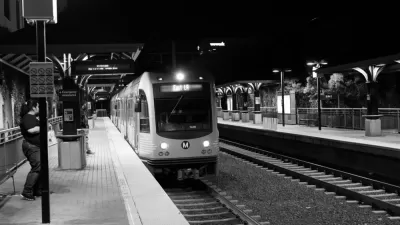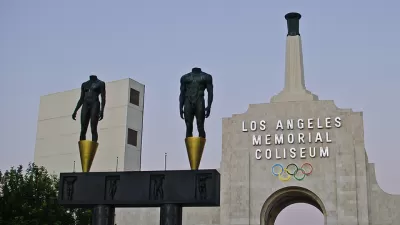Research links high ridership levels with lower crime, signaling that, rather than introducing new security measures, transit agencies should focus on bringing riders back to their systems.

In an opinion piece in the Los Angeles Times, Madeline Brozen urges Los Angeles Metro to look to the system’s buses as a model for how to improve transit safety.
While the agency is deploying added security, transit ambassadors, and other tools such as loud music to deter crime in its stations, Brozen writes that those may not be enough to make trains safer. Yet riders on the system’s buses experience far less crime than train users. “Buses aren’t safer because their rubber tires act like crime-fighting vigilantes. The most likely explanation for why buses are safer is because more people use them.”
“As fewer people rode public transit — particularly the train system — social norms eroded. Behaviors changed from minor issues like passengers putting their feet on seats to more concerning behaviors like smoking cigarettes or openly using drugs.” According to Brozen, “The best way forward is to take lessons from the bus and get more people on board to enforce public transit’s social norms.”
To bring back ridership, Brozen suggests “focusing on rail riders who are not weekday commuters,” a strategy recently undertaken by San Francisco’s Bay Area Rapid Transit Authority (BART). Brozen also recommends activating rail stations, which are often empty and isolated.
Ultimately, “Whatever steps L.A. Metro takes to address crime should be good solutions for transit in general, not just for safety,” and transit can’t solve larger societal problems. But “The bus system’s relationship between more riders and less crime is proof positive” that boosting ridership can be one tool for addressing transit safety.
FULL STORY: Opinion: How can L.A. Metro make train service safer? Look to what’s working on buses

Planetizen Federal Action Tracker
A weekly monitor of how Trump’s orders and actions are impacting planners and planning in America.

San Francisco's School District Spent $105M To Build Affordable Housing for Teachers — And That's Just the Beginning
SFUSD joins a growing list of school districts using their land holdings to address housing affordability challenges faced by their own employees.

The Tiny, Adorable $7,000 Car Turning Japan Onto EVs
The single seat Mibot charges from a regular plug as quickly as an iPad, and is about half the price of an average EV.

With Protected Lanes, 460% More People Commute by Bike
For those needing more ammo, more data proving what we already knew is here.

In More Metros Than You’d Think, Suburbs are Now More Expensive Than the City
If you're moving to the burbs to save on square footage, data shows you should think again.

The States Losing Rural Delivery Rooms at an Alarming Pace
In some states, as few as 9% of rural hospitals still deliver babies. As a result, rising pre-term births, no adequate pre-term care and "harrowing" close calls are a growing reality.
Urban Design for Planners 1: Software Tools
This six-course series explores essential urban design concepts using open source software and equips planners with the tools they need to participate fully in the urban design process.
Planning for Universal Design
Learn the tools for implementing Universal Design in planning regulations.
Smith Gee Studio
City of Charlotte
City of Camden Redevelopment Agency
City of Astoria
Transportation Research & Education Center (TREC) at Portland State University
US High Speed Rail Association
City of Camden Redevelopment Agency
Municipality of Princeton (NJ)





























